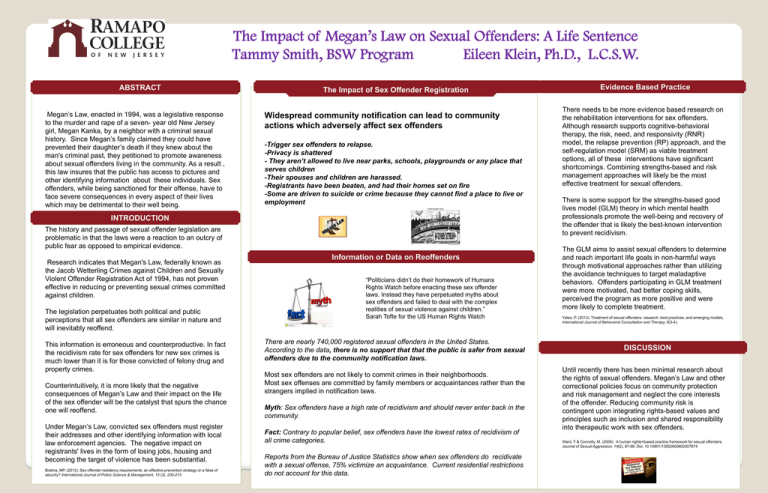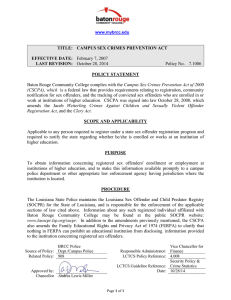
The Impact of Megan’s Law on Sexual Offenders: A Life Sentence
Tammy Smith, BSW Program
Eileen Klein, Ph.D., L.C.S.W.
ABSTRACT
Megan’s Law, enacted in 1994, was a legislative response
to the murder and rape of a seven- year old New Jersey
girl, Megan Kanka, by a neighbor with a criminal sexual
history. Since Megan’s family claimed they could have
prevented their daughter’s death if they knew about the
man's criminal past, they petitioned to promote awareness
about sexual offenders living in the community. As a result ,
this law insures that the public has access to pictures and
other identifying information about these individuals. Sex
offenders, while being sanctioned for their offense, have to
face severe consequences in every aspect of their lives
which may be detrimental to their well being.
METHOD
The Impact of Sex Offender Registration
Widespread community notification can lead to community
actions which adversely affect sex offenders
-Trigger sex offenders to relapse.
-Privacy is shattered
- They aren’t allowed to live near parks, schools, playgrounds or any place that
serves children
-Their spouses and children are harassed.
-Registrants have been beaten, and had their homes set on fire
-Some are driven to suicide or crime because they cannot find a place to live or
employment
INTRODUCTION
The history and passage of sexual offender legislation are
problematic in that the laws were a reaction to an outcry of
public fear as opposed to empirical evidence.
Research indicates that Megan's Law, federally known as
the Jacob Wetterling Crimes against Children and Sexually
Violent Offender Registration Act of 1994, has not proven
effective in reducing or preventing sexual crimes committed
against children.
The legislation perpetuates both political and public
perceptions that all sex offenders are similar in nature and
will inevitably reoffend.
This information is erroneous and counterproductive. In fact
the recidivism rate for sex offenders for new sex crimes is
much lower than it is for those convicted of felony drug and
property crimes.
Counterintuitively, it is more likely that the negative
consequences of Megan’s Law and their impact on the life
of the sex offender will be the catalyst that spurs the chance
one will reoffend.
Under Megan’s Law, convicted sex offenders must register
their addresses and other identifying information with local
law enforcement agencies. The negative impact on
registrants' lives in the form of losing jobs, housing and
becoming the target of violence has been substantial.
Bratina, MP. (2013). Sex offender residency requirements: an effective prevention strategy or a false of
security? International Journal of Police Science & Management, 15 (3). 200-213
Information or Data on Reoffenders
“Politicians didn’t do their homework of Humans
Rights Watch before enacting these sex offender
laws. Instead they have perpetuated myths about
sex offenders and failed to deal with the complex
realities of sexual violence against children.”
Sarah Tofte for the US Human Rights Watch
There are nearly 740,000 registered sexual offenders in the United States.
According to the data, there is no support that that the public is safer from sexual
offenders due to the community notification laws.
Most sex offenders are not likely to commit crimes in their neighborhoods.
Most sex offenses are committed by family members or acquaintances rather than the
strangers implied in notification laws.
Myth: Sex offenders have a high rate of recidivism and should never enter back in the
community.
Fact: Contrary to popular belief, sex offenders have the lowest rates of recidivism of
all crime categories.
Reports from the Bureau of Justice Statistics show when sex offenders do recidivate
with a sexual offense, 75% victimize an acquaintance. Current residential restrictions
do not account for this data.
Evidence Based Practice
There needs to be more evidence based research on
the rehabilitation interventions for sex offenders.
Although research supports cognitive-behavioral
therapy, the risk, need, and responsivity (RNR)
model, the relapse prevention (RP) approach, and the
self-regulation model (SRM) as viable treatment
options, all of these interventions have significant
shortcomings. Combining strengths-based and risk
management approaches will likely be the most
effective treatment for sexual offenders.
There is some support for the strengths-based good
lives model (GLM) theory in which mental health
professionals promote the well-being and recovery of
the offender that is likely the best-known intervention
to prevent recidivism.
The GLM aims to assist sexual offenders to determine
and reach important life goals in non-harmful ways
through motivational approaches rather than utilizing
the avoidance techniques to target maladaptive
behaviors. Offenders participating in GLM treatment
were more motivated, had better coping skills,
perceived the program as more positive and were
more likely to complete treatment.
Yates, P. (2013). Treatment of sexual offenders: research, best practices, and emerging models,
International Journal of Behavioral Consultation and Therapy, 8(3-4).
DISCUSSION
Until recently there has been minimal research about
the rights of sexual offenders. Megan’s Law and other
correctional policies focus on community protection
and risk management and neglect the core interests
of the offender. Reducing community risk is
contingent upon integrating rights-based values and
principles such as inclusion and shared responsibility
into therapeutic work with sex offenders.
Ward, T & Connolly, M. (2008). A human rights=based practice framework for sexual offenders.
Journal of Sexual Aggression, 14(2), 87-98. Doi: 10.10801/13552600802007874






